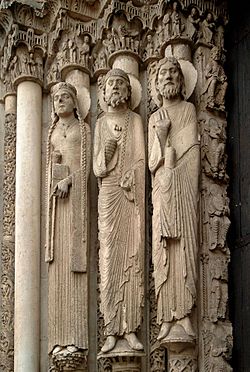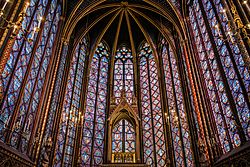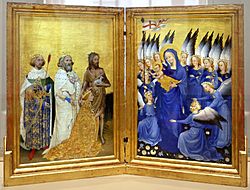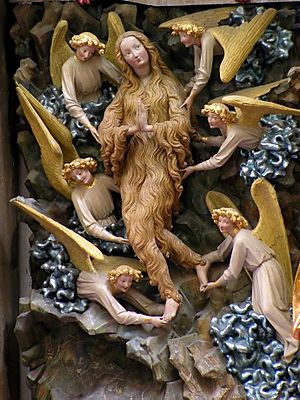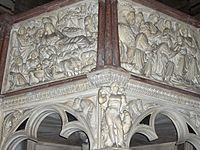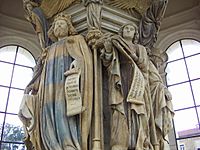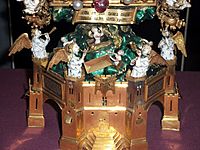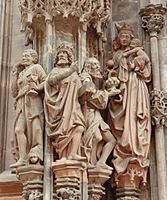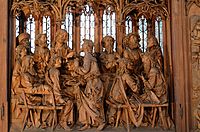Gothic art facts for kids
|
Top: The Western (Royal) Portal of the Chartres Cathedral (circa 1145), these architectural statues being the earliest Gothic sculptures and a revolution in style and the model for a generation of sculptors; Centre: The Sainte-Chapelle from Paris (1194-1248); Bottom: The Wilton Diptych (1395–1459)
|
|
| Years active | Late 12th century-16th century |
|---|---|
Gothic art was a popular art style in the Middle Ages. It started in Northern France around the 12th century. This style grew alongside Gothic architecture, which is known for its tall, grand buildings.
Gothic art spread across Western Europe and into many parts of Northern, Southern, and Central Europe. It lasted until the 16th century in some areas, especially Germany. After that, the Renaissance art style became more popular.
Artists used many different ways to create Gothic art. They made sculptures, panel paintings, stained glass windows, frescos (wall paintings), and illuminated manuscripts (decorated books). The changes in building styles, from Romanesque to Gothic and then to Renaissance, often help us understand these art periods.
Early Gothic art often featured large sculptures on the walls of cathedrals and abbeys. Christian art showed stories from the New Testament and the Old Testament. Pictures of the Virgin Mary changed during this time. She was shown as a more human and loving mother, holding her baby, rather than in a stiff, formal way.
Art for everyday people also became more common. Cities grew, universities were founded, and trade increased. This led to more people having money to buy art. Artists often joined guilds, which were like professional groups. Because of better records, we know the names of more artists from this time than ever before. Some artists even signed their work!
Contents
Where Gothic Art Began
Gothic art first appeared in Île-de-France, France, in the early 12th century. It started at the Abbey Church of St Denis, built by Abbot Suger. The style quickly moved from buildings to other art forms. This included large and small sculptures, textile art, and paintings.
Paintings came in different forms: frescos, stained glass windows, illuminated manuscripts, and panel paintings. Religious groups, like the Cistercians and Carthusians, built many churches. They helped spread the Gothic style and created their own versions across Europe.
By the late 14th century, a style called International Gothic developed. This was a common style seen across Europe. It continued until the late 15th century and even longer in some places.
Most art from this period was religious. It was made for churches or for people who wanted religious art for their homes. Gothic art often showed how events from the Old Testament were connected to the New Testament.
The Gothic period also saw a big increase in devotion to the Virgin Mary. Art played a huge part in this. Pictures of Mary became more human and personal. Artists like Giotto and Fra Angelico in Italy made art feel more real and natural. Artists and their patrons (people who paid for art) became more confident in trying new ideas for their art.
Art also changed because of new religious ideas. For example, images of Christ showing his human suffering became more common. Even in scenes of the Last Judgment, Christ was often shown with the wounds from his Passion. Saints were shown more often, especially on altarpieces. These were artworks placed behind church altars.
What "Gothic" Means

The word "Gothic" was first used to mean "Barbaric". People who didn't like this art style thought it was rough and not as beautiful as Classical art. During the Renaissance, some writers believed that the attack on Rome by the Gothic tribes in 410 AD destroyed classical values.
In the 15th century, Italian artists complained that the new "barbarian" styles from northern Europe were a threat. The artist Raphael used the term "Gothic" around 1518. Later, Giorgio Vasari, another Italian artist and writer, called Gothic art "monstrous and barbarous" in 1530.
Raphael even joked that the pointed arches of northern buildings looked like primitive huts. These huts were supposedly made by Germanic forest dwellers bending trees together. This idea later became more positive in German Romanticism.
At first, Gothic art was called "French work" (Opus Francigenum). This showed that France was the main place where this new style began.
Gothic Painting
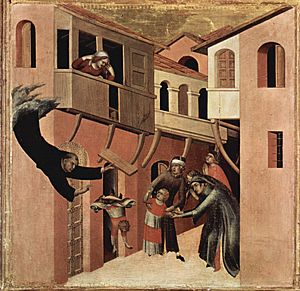
Gothic painting started around 1200, about 50 years after Gothic buildings and sculptures. The change from the earlier Romanesque style to Gothic was not sudden. At first, only small Gothic details appeared in art.
Then, figures in paintings became more lively. Their poses and faces showed more emotion. They also appeared smaller compared to the background. This change happened first in England and France around 1200. It came to Germany around 1220 and Italy around 1300.
During the Gothic period, painting was done in four main ways:
- frescos (wall paintings)
- panel paintings (paintings on wooden panels)
- manuscript illumination (decorating books)
- stained glass windows
Frescoes
In southern Europe, frescoes continued to be important for telling stories on church walls. This was a tradition from earlier Christian and Romanesque art. In Denmark and Sweden, many church wall paintings have survived. They were often covered with whitewash after the Reformation, which protected them.
One famous artist from this time in Denmark was the Elmelunde Master. He decorated churches like Fanefjord and Keldby. In Sweden, Albertus Pictor was a well-known fresco artist. You can see his work in churches like Tensta and Gökhem.
Stained Glass
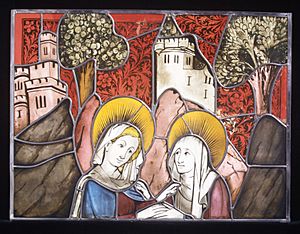
In northern Europe, stained glass was a very important and respected art form. It was popular until the 15th century, when panel painting became more common. Gothic buildings often had huge windows, allowing for large stained glass designs. This included big rose windows.
Early stained glass used mostly black paint and clear or bright colored glass. By the early 14th century, artists started using silver compounds. They painted these onto the glass and then fired it. This allowed them to create different shades of yellow on clear glass in one piece. Later, designs used larger pieces of painted glass, with yellow as the main color.
Manuscripts and Printmaking
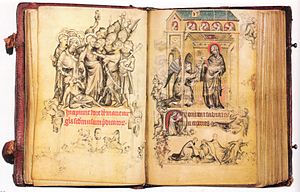
Illuminated manuscripts give us the best look at Gothic painting. They show us styles from places where other large artworks have not survived. The first French Gothic illustrated books appeared in the mid-13th century. Many of these were royal bibles, but psalters (books of psalms) also had pictures.
The Parisian Psalter of Saint Louis, from 1253 to 1270, has 78 full-page pictures. These were made with tempera paint and gold leaf.
In the late 13th century, people started making prayer books for ordinary people. These were often called books of hours because they were used at certain times of the day. One early example was made by William de Brailes around 1240. Rich people often bought these books and paid a lot for the decorations.
Jean Pucelle was a famous artist who made these books. His Hours of Jeanne d'Evreux was ordered by King Charles IV as a gift for his queen. French Gothic books used decorative borders that looked like architecture. They also had tall, detailed figures. Artists used elements like buildings, trees, and clouds to show space.
By the mid-14th century, blockbooks became popular in the Low Countries. These books had both text and pictures cut from wood. They were affordable for parish priests. By the end of the century, printed books with illustrations were available to the middle class. Engravings by artists like Israhel van Meckenem were also popular.
In the 15th century, cheap prints, mostly woodcuts, became available. Even peasants could have religious pictures at home. These small, often crudely colored images were sold by the thousands. Today, they are very rare because most were pasted onto walls.
Altarpiece and Panel Painting
Painting with oil on canvas became popular in the 15th and 16th centuries. This was a key feature of Renaissance art. In Northern Europe, the important Early Netherlandish painting school used a Gothic style. However, it is also seen as part of the Northern Renaissance.
Painters like Robert Campin and Jan van Eyck used oil painting to create very detailed works. They used correct perspective and combined realism with complex symbolism. This symbolism came from the tiny details they could now include.
In Early Netherlandish painting, artists combined new realism in oil painting with subtle religious meanings. These meanings were shown through the highly detailed settings of religious scenes. Examples include the Mérode Altarpiece (1420s) by Robert Campin and the Washington Van Eyck Annunciation (1430s) by Jan van Eyck.
For wealthy people, small panel paintings, sometimes even polyptychs (multi-panel artworks), became very popular. These often included donor portraits, showing the people who paid for the art. These artworks were usually displayed in homes.
Gothic Sculpture
Large Sculptures
The Gothic period is mostly known for its Gothic architecture. However, sculpture also developed during this time. The fronts of large churches, especially around the doors, had big carved areas called tympanums. They also had rows of sculpted figures around them.
The statues on the Western (Royal) Portal at Chartres Cathedral (around 1145) are tall and thin. But those on the south transept portal, from 1215–20, look more natural. They also stand out more from the wall. These changes continued at Reims Cathedral a few years later. There, the figures are almost fully rounded, which became common as Gothic art spread.
Bamberg Cathedral has many 13th-century sculptures. The most famous is the Bamberg Rider from 1240. This was the first life-size equestrian statue (a statue of a person on a horse) in Western art since the 6th century.
In Italy, Gothic sculpture was often found in pulpits (raised platforms for speaking). Sculptors focused on creating artworks that could stand alone.
Around 1400, artists like Claus Sluter in Burgundy and Flanders brought back some classical styles. Late Gothic sculpture continued in the North. There was a trend for very large, wooden, carved altarpieces. These had many detailed figures. Most surviving examples are in Germany.
Artists like Tilman Riemenschneider and Veit Stoss continued this style into the 16th century. They slowly started to include ideas from the Italian Renaissance.
Life-size statues for tombs became popular for wealthy people. Grand, multi-level tombs also developed. The Scaliger Tombs in Verona were so large they had to be moved outside the church. By the 15th century, there was a business exporting Nottingham alabaster altar reliefs. These were groups of carved panels that were cheaper for churches than stone altarpieces.
-
South portal of Chartres Cathedral (c. 1215–20).
-
West portal at Reims Cathedral, Annunciation group.
-
Nicola Pisano, Nativity and Adoration of the Magi from the pulpit of the Pisa Baptistery.
-
Claus Sluter, David and a prophet from the Well of Moses.
-
Panelled altarpiece section with Resurrection of Christ, English Nottingham alabaster, 1450–90, with remains of colour.
-
Later Gothic depiction of the Adoration of the Magi from Strasbourg Cathedral.
-
Detail of the Last Supper from Tilman Riemenschneider's Altar of the Holy Blood, 1501–05, carved limewood, Rothenburg ob der Tauber, Bavaria.
Small Sculptures

Small carvings became a big business in Paris and other cities. These were mainly for everyday people, often women. They included small religious artworks called polyptychs, single figures (especially of the Virgin Mary), mirror-cases, combs, and fancy boxes with scenes from romantic stories. These boxes were often given as engagement presents.
Very wealthy people collected expensive metalwork decorated with jewels and enamel. These items were both religious and non-religious, like the Duc de Berry's Holy Thorn Reliquary.
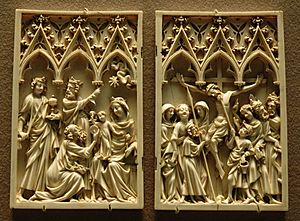
Gothic sculptures that were not part of buildings were mostly made for homes. They were also given as gifts to local churches. Small reliefs (carvings that stick out from a flat surface) made of ivory, bone, and wood showed both religious and everyday subjects. These were used in churches and homes.
City artists created these sculptures. The most common small statues were of the Virgin Mary alone or with baby Jesus. Paris was the main center for ivory carving. It exported its work to most of northern Europe.
An example of these sculptures is the silver-gilt Virgin and Child from the Abbey Church of St Denis. It dates to 1339 and shows Mary in a flowing cloak holding a young Christ. This simple style and the young child can be seen in other sculptures from the 14th and early 15th centuries in northern Europe.
These sculptures show a change from a stiff, tall style (which was still partly Romanesque). They became more natural and showed more depth in the late 12th and early 13th centuries. Other French Gothic sculptures showed figures and scenes from popular stories of the time. Images from troubadour poetry were very popular on mirror-cases and small boxes for women. The Casket with Scenes of Romances (Walters 71264) from 1330–50 is a large example with many scenes from different stories.
Souvenirs from religious trips, like clay or lead badges, medals, and ampullae (small bottles) with images, were also popular and cheap. Similar items, called livery badges, showed loyalty to a lord or political group. These became a problem in England because they showed loyalty to powerful individuals rather than the king.
Cheaper badges were sometimes given away for free. For example, King Richard III of England ordered 13,000 badges in 1483. These were made of cloth with his symbol, a white boar. They were for his son Edward becoming Prince of Wales. This was a huge number for the time. The Dunstable Swan Jewel, made of gold and enamel, was a much more expensive version. It would have been given to someone very important to the giver.
See also
 In Spanish: Arte gótico para niños
In Spanish: Arte gótico para niños
- Blackletter (also known as Gothic script)
- Church frescos in Denmark
- Church frescos in Sweden
- Danse Macabre
- Gothic cathedrals and churches
- History of painting
- List of Gothic artists
- Pleurants
- Renaissance of the 12th century
- The Ten Virgins
- Timeline of Italian artists to 1800
- Western painting


